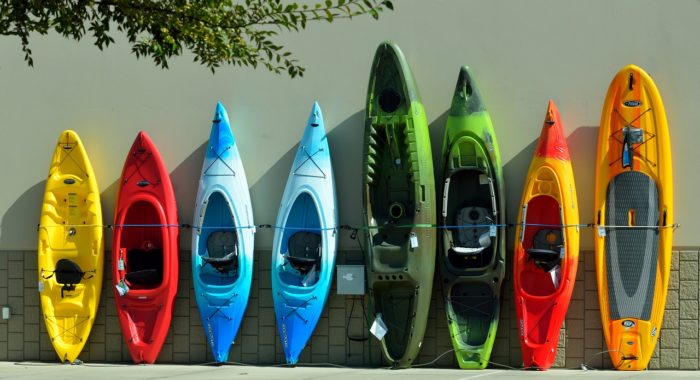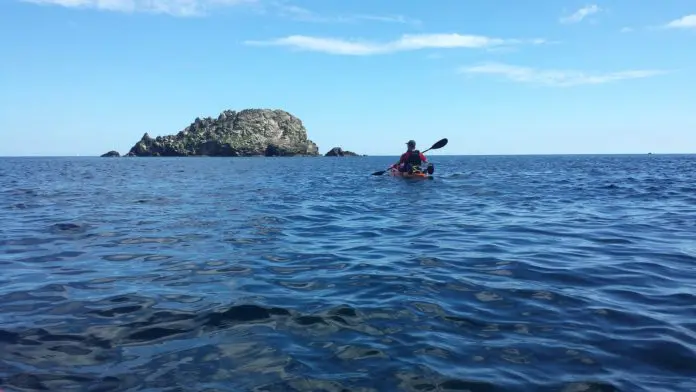The modern kayak has evolved from a designed developed by the Inuit, Yup’ik, and Aleut peoples over 4,000 years ago.
Originally designed for hunting and fishing in the cold Arctic waters — inland lakes, rivers and coastal waters of the Arctic Ocean, Bering Sea, North Atlantic, and the North Pacific oceans — you are more likely to find the modern kayak in tropical and temperate waters. While human-powered, many kayaking enthusiasts still use them for hunting and fishing. The sport of kayaking has many other supporters, using them for recreation and exploring remote natural areas.
One popular use of them in some regions is as a dive platform. Often considered a bridge between shore diving and boat diving, the kayak can open up many dive opportunities that bypass many divers.
While both shore diving and diving from a dive boat are great, there are times when something is missing. There is a number of potentially great dive sites that are somewhat close to shore but are difficult, even impossible, to do as a shore dive. Inaccessible shore access or strong surf may be a reason. The intended dive site might be a bit far for a surface swim. Other locations may prove to be dangerous to a boat because of shallow water. Depending on the skill level of the kayaker, they may also reach many dive sites used by dive boats.
Purchasing a kayak is less expensive than buying a dive boat. The maintenance costs are virtually zero and the cost of operating them is limited to a few extra energy bars. Most cars can transport a couple of kayaks with the addition of a roof carrier if the vehicle is not already equipped. This also makes storage of your dive platform less expensive. No need to pay for a boat slip or rent storage space. It is also easier to find places to launch your kayak than to launch a dive boat. If you can pull your kayak to the water, you will likely be able to launch.
What Kayaking Skills Are Needed?
Learning the basic skills of kayaking is very simple. Just about any place that rents kayaks will include a 20-minute lesson giving you enough knowledge to get you started. However, just like your Open Water Diver course, it is just the basics that are used to improve your skills. Some practice and maybe some skilled supervision will be needed before you reach a level of comfort that will enable you to control the kayak in a safe manner.
One item to keep in the forefront while considering kayak diving is that it just you and your diving buddy out in nature. Your kayaking skills need to be strong enough to balance the situation you might find yourself in. You have to paddle the distance to your dive site, dive, and paddle back. Depending on the dive site, you may encounter currents and remember that wind also impacts your ability to paddle effectively. Before heading out in the open seas, consider modifying the rule of one-third, i.e. limiting your dive sites to a distance of 1/3 of what you can comfortably paddle.

What Type of Kayak?
Kayak design varies for the purpose they will be used. A person planning on kayaking white water will get a kayak that is short, a tight fit and easy to maneuver. A recreational kayak is best suited for calm waters like lakes and slow-moving rivers. Sea kayaks or touring kayaks are designed for rougher waters and carrying larger cargo. There are a few models of kayaks that are designed for scuba diving, however, most divers use kayaks adapted from other models to meet their needs. Your first step is to see what kayakers are using in the area you plan on diving.
Kayaks are also divided into two styles, the traditional sit-in, and the more recent sit-on-top. For the sit-in version, the seat is on the hull and the person’s legs are below the upper edge of the kayak. Much of the kayak is covered. Some have small openings.
Many people who kayak also snorkel and the style they prefer is the sit-on-top version. As the name implies, the person is sitting on the top of the kayak. While they might be sitting slightly lower than the sides of the kayak, everything is open. They often will have molded areas to stow items that are lashed down. Because the top of these kayaks is open, they are easier to get into and out of especially in the water.
Some of the most popular designs are those for fishermen. They are stable and often have larger storage areas that those designed for other pursuits.
Scuba Diving
Back in your Open Water Diver training, you practiced putting on your equipment while in the water. If you are like most divers, that was the last time you did that. When diving from a kayak, that is the method you will use to don your gear. Before loading your gear onto the kayak, you will need to completely assemble it. When you do load it, you will use bungee cords to secure it in the well of the kayak, add air to the BCD so it is buoyant and tether it to the kayak.
Everything you put into the kayak must be secured and tethered. It should be laid out so that you can reach the items you need, in the order you will use them.
Paddle out to your dive site at a comfortable pace. When you reach your site, tether the paddle, and anchor or moor the kayak. You may also want to tether your kayak with your dive buddies. Put up your diver down flag, then put on your fins, mask, and snorkel. Whether you enter the water first or put your kit on beforehand will be a personal preference that might be influenced by the kayak’s design. Either way, make sure the BCD is tethered before you let it loose. Once you have your BCD on, it is like any other dive.
Using the kayak as a platform allows you to conduct the dive in a few different ways: You can leave the anchor or mooring as it is and explore around the area. If you are planning a drift dive, they the kayak becomes your diver down float as well. Clip the down line to your BCD, and let the kayak follow you.
When you start your return to the kayak, proceed as you would normally. Many divers take the extra precaution of using a DSMB when they are at the safety stop. Just in case someone is looking to investigate a couple of empty kayaks or are using them in a slalom race. At the surface, inflate your BCD and tether it to your kayak. Practice will tell you if it is easier to lift the BCD on-board from the water or pull it up after you get back on. To get yourself back on board, use your fins to help propel you.
Secure all your gear, have a drink, relax and when you are ready, retrieve your anchor and paddle back to your start point.
It might take you some time before you are totally comfortable with this style of diving and ready to purchase your own kayak. There are dive centers in different parts of the world that rent kayaks for diving. If there are none near you, look on your next dive vacation.

